The Global Land Surface Satellite (GLASS) Remote Sensing Data Processing System and Products
Abstract
:1. Introduction
2. Product Generation System
2.1. System Structure and Configuration
2.2. High-Performance Parallel Computing System
2.3. Multitask Management and Operation
- * A product generation job can be created in the user interface and be sent to a task server. A job is often more of an application-level term and simply refers to some script that is executed to do a specific set of tasks.
- * A task server creates tasks, dispatches them to cluster nodes, and processes returned tasks. A task is often a part of a job and sometimes is the only part. The Simple Linux Utility for Resource Management (SLURM) Version 2.2 has been used as the cluster resource manager. SLURM is an open source, fault-tolerant, and highly scalable cluster management and job scheduling system for large and small Linux clusters [22]. It provides a framework for starting, executing, and monitoring work (normally a parallel job) on the set of allocated nodes.
- * Every task will run in its own thread. While the tasks within the parallel task are being run, the main thread will be blocked and will wait for all the child threads to be completed. In Figure 2, the thread0 is the main thread that is responsible for distributing, receiving and summarizing data, while the others are concerned with computation. All of these threads are optimized according to their computing time. That means if one task is finished, the thread can be reused.
3. GLASS System Performance and Products
3.1. Performance Measurements
3.2. Product Format and Metadata
GLASS stands for the Global LAnd Surface Satellite productsXX stands for the types of GLASS products, 01: LAI; 02: albedo; 03: BBE; 04: PAR; 05: DSRN stands for spatial resolution, which is labeled A, B, and CYY stands for codes for different types of GLASS products, which depend on the algorithm and data sources of the productsAYYYYDDD stands for the time of the products, YYYY is for year, and DDD is for Julian dayHRRVPP stands for tile ID (path/row number), HRR-row number, VPP-path number. HRRVPP is not validated when the product is processed by the AVHRR dataYYYYDDD stands for the process time of the productshdf stands for the data format (HDF-EOS Version 2.16)
3.3. Product Descriptions
3.2.1. Preprocessed Data
3.2.2. LAI Products
3.2.3. Albedo Products
3.2.4. BBE Products
3.2.5. DSR and PAR Products
4. Quality Control
5. GLASS Products Service
6. Summary
Acknowledgments
References
- Schowengerdt, R.A. Remote Sensing: Models and Methods for Image Processing, 3rd ed.; Academic Press: San Diego, CA, USA, 2007. [Google Scholar]
- Liang, S. Quantitative Remote Sensing of Land Surfaces; John Wiley and Sons Inc: Hoboken, NJ, USA, 2004. [Google Scholar]
- Gutman, G.G. Vegetation indices from AVHRR: An update and future prospects. Remote Sens. Environ 1991, 35, 121–136. [Google Scholar]
- Savtchenko, A.; Ouzounov, D.; Ahmad, S.; Acker, J.; Leptoukh, G.; Koziana, J.; Nickless, D. Terra and Aqua MODIS products available from NASA GES DAAC. Adv. Space Res 2004, 34, 710–714. [Google Scholar]
- Vicente-Serrano, S.M.; Pérez-Cabello, F.; Lasanta, T. Assessment of radiometric correction techniques in analyzing vegetation variability and change using time series of Landsat images. Remote Sens. Environ 2008, 112, 3916–3934. [Google Scholar]
- Martínez, B.; Gilabert, M.A. Vegetation dynamics from NDVI time series analysis using the wavelet transform. Remote Sens. Environ 2009, 113, 1823–1842. [Google Scholar]
- Kleynhans, W.; Olivier, J.C.; Wessels, K.J.; van den Bergh, F.; Salmon, B.P.; Steenkamp, K.C. Improving land cover class separation using an extended Kalman filter on MODIS NDVI time-series data. IEEE Geosci. Remote Sens. Lett 2010, 7, 381–385. [Google Scholar]
- Kleynhans, W.; Olivier, J.C.; Wessels, K.J.; Salmon, B.P.; van den Bergh, F.; Steenkamp, K. Detecting land cover change using an extended Kalman filter on MODIS NDVI time-series data. IEEE Geosci. Remote Sens. Lett 2011, 8, 507–511. [Google Scholar]
- Omuto, C.T. A new approach for using time-series remote-sensing images to detect changes in vegetation cover and composition in drylands: A case study of eastern Kenya. Int. J. Remote Sens 2011, 32, 6025–6045. [Google Scholar]
- Pan, Y.; Li, L.; Zhang, J.; Liang, S.; Zhu, X.; Sulla-Menashe, D. Winter wheat area estimation from MODIS-EVI time series data using the Crop Proportion Phenology Index. Remote Sens. Environ 2012, 119, 232–242. [Google Scholar]
- Spruce, J.P.; Sader, S.; Ryan, R.E.; Smoot, J.; Kuper, P.; Ross, K.; Prados, D.; Russell, J.; Gasser, G.; McKellip, R.; Hargrove, W. Assessment of MODIS NDVI time series data products for detecting forest defoliation by gypsy moth outbreaks. Remote Sens. Environ 2011, 115, 427–437. [Google Scholar]
- Redo, D.J.; Millington, A.C. A hybrid approach to mapping land-use modification and land-cover transition from MODIS time-series data: A case study from the Bolivian seasonal tropics. Remote Sens. Environ 2011, 115, 353–372. [Google Scholar]
- Sakamoto, T.; Wardlow, B.D.; Gitelson, A.A.; Verma, S.B.; Suyker, A.E.; Arkebauer, T.J. A two-step filtering approach for detecting maize and soybean phenology with time-series MODIS data. Remote Sens. Environ 2010, 114, 2146–2159. [Google Scholar]
- Justice, C.O.; Townshend, J.R.G.; Vermote, E.F.; Masuoka, E.; Wolfe, R.E.; Saleous, N.; Roy, D.P.; Morisette, J.T. An overview of MODIS Land data processing and product status. Remote Sens. Environ 2002, 83, 3–15. [Google Scholar]
- Justice, C.O.; Giglio, L.; Korontzi, S.; Owens, J.; Morisette, J.T.; Roy, D.; Descloitres, J.; Alleaume, S.; Petitcolin, F.; Kaufman, Y. The MODIS fire products. Remote Sens. Environ 2002, 83, 244–262. [Google Scholar]
- Zhang, W.; Wang, L.; Liu, D.; Song, W.; Ma, Y.; Liu, P.; Chen, D. Towards building a multi-datacenter infrastructure for massive remote sensing image processing. Concurr. Comp. Pract. E. 2012. [Google Scholar] [CrossRef]
- Ma, Y.; Wang, L.; Liu, D.; Yuan, T.; Liu, P.; Zhang, W. Distributed data structure templates for data-intensive remote sensing applications. Concurr. Comp. Pract. E. 2012. [Google Scholar] [CrossRef]
- Fensholt, R.; Proud, S.R. Evaluation of Earth Observation based global long term vegetation trends—Comparing GIMMS and MODIS global NDVI time series. Remote Sens. Environ 2012, 119, 131–147. [Google Scholar]
- Wang, K.; Dickinson, R.E.; Liang, S. Clear sky visibility has decreased over land globally from 1973 to 2007. Science 2009, 323, 1468–1470. [Google Scholar]
- Masuoka, E.; Tilmes, C.; Devine, N.; Gang, Y.; Tilmes, M. Evolution of the MODIS Science Data Processing System. In Proceedings of IEEE 2001 International Geoscience and Remote Sensing Symposium (IGARSS’01), Sydney, NSW, Australia, 9–13 July 2001; pp. 1454–1457.
- Pakin, S.; Lang, M.; Kerbyson, D.J. The reverse-acceleration model for programming petascale hybrid systems. IBM J. Res. Dev 2009, 53, 721–735. [Google Scholar]
- Jette, M.; Grondona, M. SLURM: Simple Linux Utility for Resource Management. In Proceedings of ClusterWorld Conference and Expo, San Jose, CA, USA, 23–26 June 2003; pp. 1–31.
- Xiao, Z.; Liang, S. Leaf area index retrieval from MODIS time series data using general regression neural networks. Int. J. Digit. Earth 2013. in review.. [Google Scholar]
- Barnes, W.L.; Pagano, T.S.; Salomonson, V.V. Prelaunch characteristics of the Moderate Resolution Imaging Spectroradiometer (MODIS) on EOS-AM1. IEEE Trans. Geosci. Remote Sens 1998, 36, 1088–1100. [Google Scholar]
- Chen, J.M.; Black, T.A. Defining leaf area index for non-flat leaves. Plant. Cell Environ 1992, 15, 421–429. [Google Scholar]
- Strugnell, N.C.; Lucht, W. An algorithm to infer continental-scale albedo from AVHRR data, land cover class, and field observations of typical BRDFs. J. Clim 2001, 14, 1360–1376. [Google Scholar]
- Dickinson, R.E. Land processes in climate models. Remote Sens. Environ 1995, 51, 27–38. [Google Scholar]
- Liang, S. Narrowband to broadband conversions of land surface albedo I: Algorithms. Remote Sens. Environ 2001, 76, 213–238. [Google Scholar]
- Qu, Y.; Liu, Q.; Liang, S.L.; Wang, L.Z.; Liu, N.F.; Liu, S.H. Direct-estimation algorithm for mapping daily land-surface broadband albedo from MODIS data. IEEE Trans. Geosci. Remote Sens. 2013, in press.. [Google Scholar]
- Liu, N.F.; Liu, Q.; Wang, L.Z.; Liang, S.L.; Wen, J.G.; Qu, Y.; Liu, S.H. Mapping spatially-temporally continuous shortwave albedo for global land surface from MODIS data. Hydrol. Earth Syst. Sci. Discuss 2012, 9, 1–22. [Google Scholar]
- Pedelty, J.A.; Devadiga, S.; Masuoka, E.J.; Brown, M.E.; Pinzon, J.E.; Tucker, C.J.; Roy, D.; Ju, J.; Vermote, E.F.; Prince, S.; et al. Generating a Long-Term Land Data Record from the AVHRR and MODIS Instruments. In Proceedings of IEEE 2007 International Geoscience and Remote Sensing Symposium (IGARSS 2007), Barcelona, Spain, 23–27 July 2007; pp. 1021–1025.
- Liu, Q.; Wang, L.; Qu, Y.; Liu, N.; Liu, S.; Tang, H.; Liang, S. Preliminary Evaluation of the Long-term GLASS albedo product. Int. J. Digit. Earth, 2013; in review. [Google Scholar]
- Cheng, J.; Liang, S.; Yao, Y.; Zhang, X. Estimating the optimal broadband emissivity spectral range for calculating surface longwave net radiation. IEEE Geosci. Remote Sens. Lett. 2012. [Google Scholar] [CrossRef]
- Ogawa, K.; Schmugge, T. Mapping surface broadband emissivity of the sahara desert using ASTER and MODIS data. Earth Interact 2004, 8, 1–14. [Google Scholar]
- Ren, H.; Liang, S.; Yan, G.; Cheng, J. Empirical algorithms to map global broadband emissivities over vegetated surfaces. IEEE Trans. Geosci. Remote Sens 2013, 51, 2619–2631. [Google Scholar]
- Cheng, J.; Liang, S. Estimating global land surface broadband thermal-infrared emissivity using advanced very high resolution radiometer optical data. Int. J. Digit. Earth, 2013; in press. [Google Scholar]
- Baldridge, A.M.; Hook, S.J.; Grove, C.I.; Rivera, G. The ASTER spectral library version 2.0. Remote Sens. Environ 2009, 113, 711–715. [Google Scholar]
- MODIS (Moderate Resolution Imaging Spectrometer) UCSB Emissivity Library. Available online: http://www.icess.ucsb.edu/modis/EMIS/html/em.html/ (accessed on 10 May 2013).
- Cheng, J.; Liang, S.; Weng, F.; Wang, J.; Li, X. Comparison of radiative transfer models for simulating snow surface thermal infrared emissivity. IEEE J. Sel. Top. Earth Obs. Remote Sens 2010, 3, 323–336. [Google Scholar]
- Pinker, R.T.; Laszlo, I. Modeling surface solar irradiance for satellite applications on a global scale. J. Appl. Meteorol 1992, 31, 194–211. [Google Scholar]
- Kim, H.-Y.; Liang, S. Development of a hybrid method for estimating land surface shortwave net radiation from MODIS data. Remote Sens. Environ 2010, 114, 2393–2402. [Google Scholar]
- Liang, S.; Zheng, T.; Liu, R.; Fang, H.; Tsay, S.-C.; Running, S. Estimation of incident photosynthetically active radiation from Moderate Resolution Imaging Spectrometer data. J. Geophys. Res 2006, 111, D15208. [Google Scholar]
- Li, Z.; Moreau, L.; Cihlar, J. Estimation of photosynthetically active radiation absorbed at the surface. J. Geophys. Res 1997, 102, 29717–29727. [Google Scholar]
- Lu, N.; Liu, R.; Liu, J.; Liang, S. An algorithm for estimating downward shortwave radiation from GMS 5 visible imagery and its evaluation over China. J. Geophys. Res 2010, 115, D18102. [Google Scholar]
- Zhang, X.; Liang, S.; Wu, H.; Zhou, G. Mapping global incident downward shortwave radiation and photosynthetically active radiation over land surfaces using multiple satellite data. J. Geophys. Res. 2013; in review. [Google Scholar]
- Distribution of Global Land Surface Remote Sensing Products Facilitating Application on Global Change Research. Available online: http://glass-product.bnu.edu.cn/en/ (accessed on 10 May 2013).
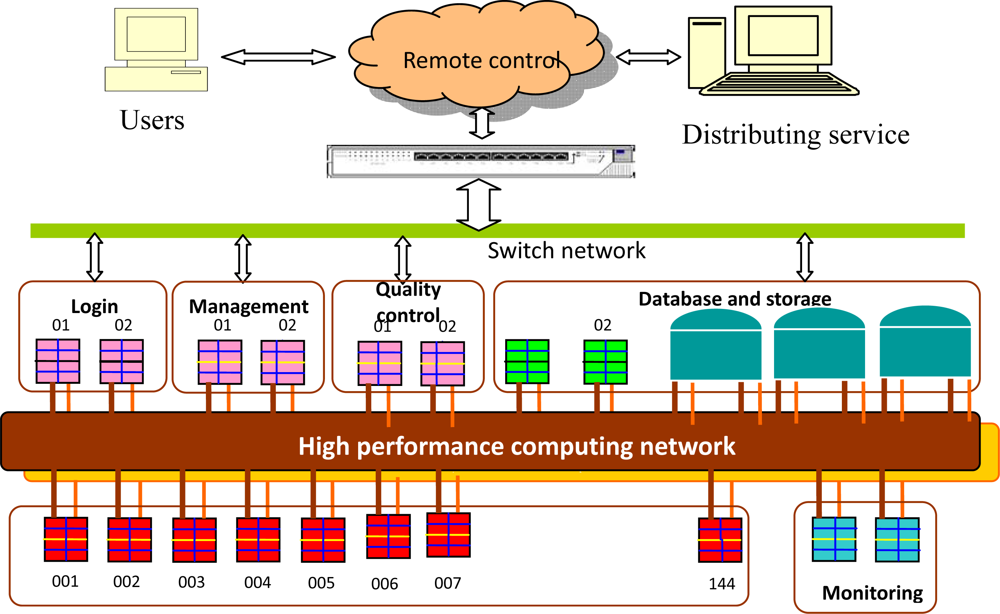

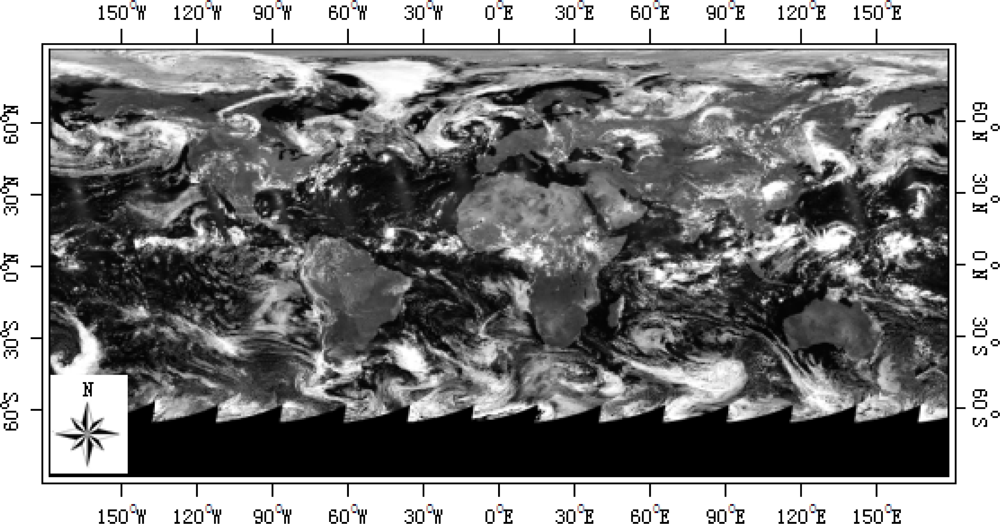

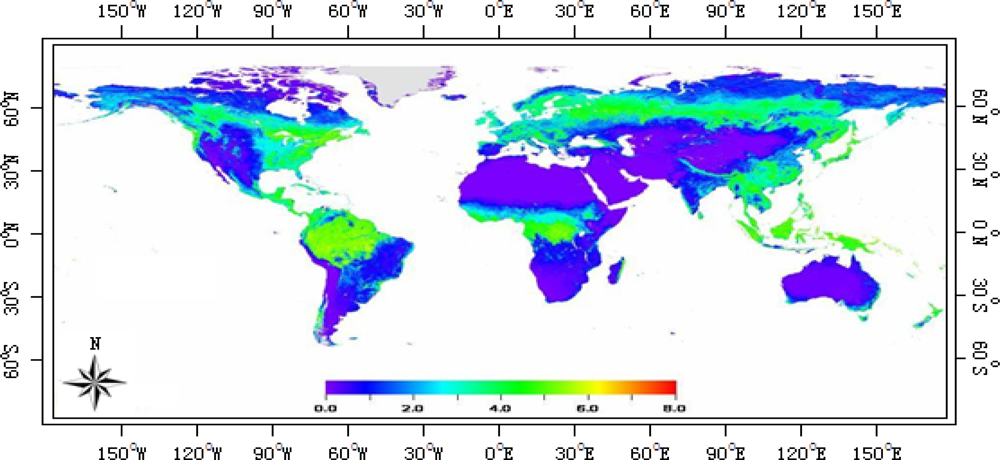
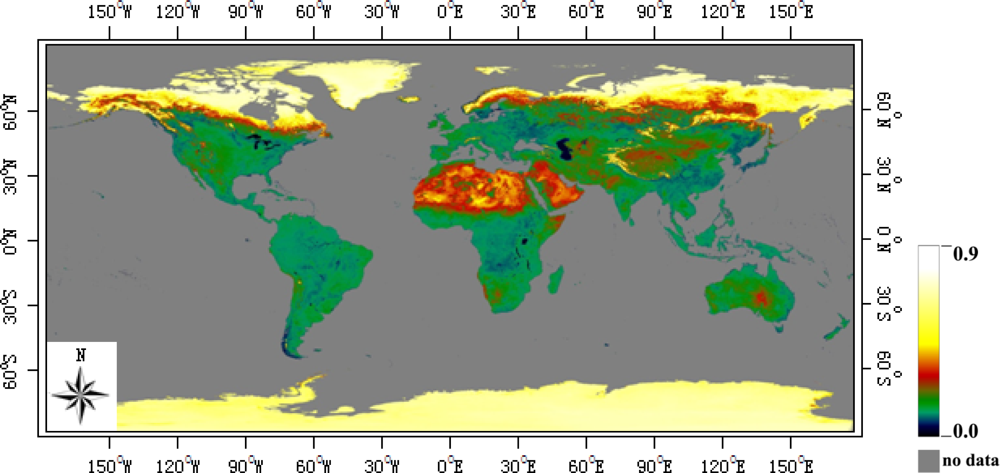
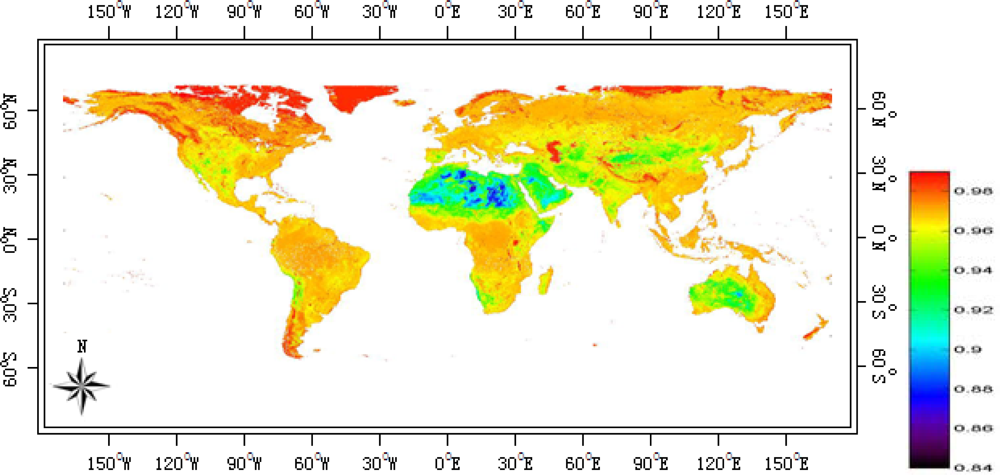
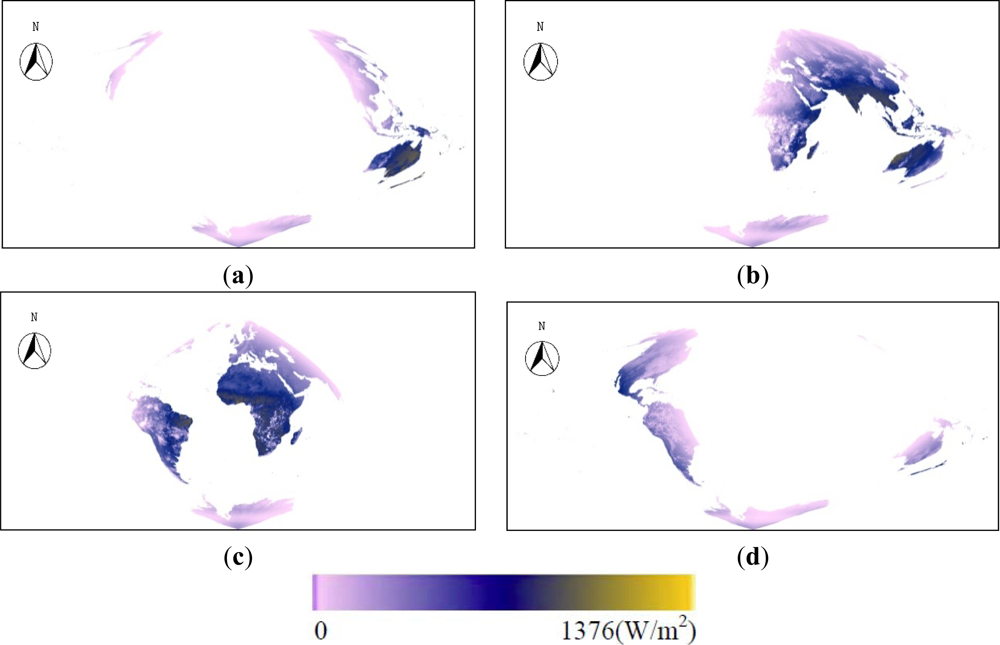
| Total Products in 2008 | Nonparallel (h) | Parallel (h) |
|---|---|---|
| LAI | 14.4 | 4 |
| Albedo | 192 | 50 |
| DSR | 85.1 | 11 |
| BBE | 8 | 2 |
© 2013 by the authors; licensee MDPI, Basel, Switzerland This article is an open access article distributed under the terms and conditions of the Creative Commons Attribution license ( http://creativecommons.org/licenses/by/3.0/).
Share and Cite
Zhao, X.; Liang, S.; Liu, S.; Yuan, W.; Xiao, Z.; Liu, Q.; Cheng, J.; Zhang, X.; Tang, H.; Zhang, X.; et al. The Global Land Surface Satellite (GLASS) Remote Sensing Data Processing System and Products. Remote Sens. 2013, 5, 2436-2450. https://doi.org/10.3390/rs5052436
Zhao X, Liang S, Liu S, Yuan W, Xiao Z, Liu Q, Cheng J, Zhang X, Tang H, Zhang X, et al. The Global Land Surface Satellite (GLASS) Remote Sensing Data Processing System and Products. Remote Sensing. 2013; 5(5):2436-2450. https://doi.org/10.3390/rs5052436
Chicago/Turabian StyleZhao, Xiang, Shunlin Liang, Suhong Liu, Wenping Yuan, Zhiqiang Xiao, Qiang Liu, Jie Cheng, Xiaotong Zhang, Hairong Tang, Xin Zhang, and et al. 2013. "The Global Land Surface Satellite (GLASS) Remote Sensing Data Processing System and Products" Remote Sensing 5, no. 5: 2436-2450. https://doi.org/10.3390/rs5052436
APA StyleZhao, X., Liang, S., Liu, S., Yuan, W., Xiao, Z., Liu, Q., Cheng, J., Zhang, X., Tang, H., Zhang, X., Liu, Q., Zhou, G., Xu, S., & Yu, K. (2013). The Global Land Surface Satellite (GLASS) Remote Sensing Data Processing System and Products. Remote Sensing, 5(5), 2436-2450. https://doi.org/10.3390/rs5052436







